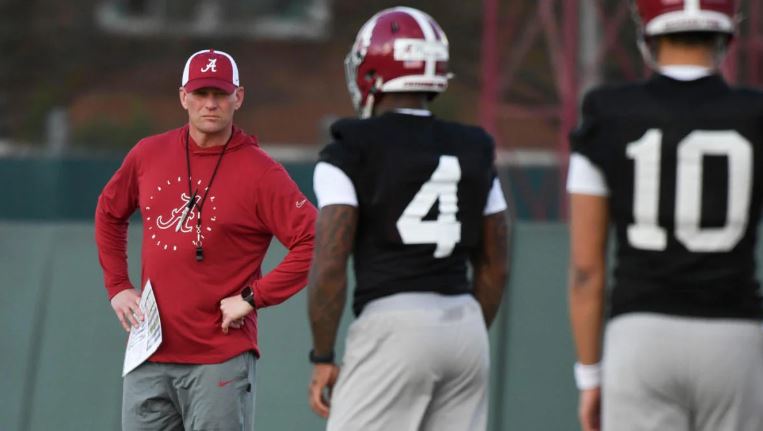
Julian Sayin, a five-star quarterback who was once a beacon of hope for the Alabama Crimson Tide, has made headlines this offseason by transferring to Ohio State. His decision to switch allegiances has sparked a flurry of discussion and speculation across the college football landscape. This move, while dramatic, is emblematic of the broader shifts that characterize the ever-evolving world of college athletics. In dissecting Sayin’s departure from Alabama and his subsequent move to Ohio State, it becomes evident that his choice was influenced by a confluence of factors, primarily centered around coaching changes and developmental opportunities.
Julian Sayin’s journey through the transfer portal was one of the most significant stories of the 2024 offseason. As one of the top quarterbacks in his class, his departure from Alabama was a major blow to a program that had invested heavily in his future. Sayin was not just a highly ranked recruit but also a player with the potential to shape the fortunes of the Crimson Tide. His move to Ohio State, a program with its own storied history and recent success, marked a significant shift in his career trajectory.
At the heart of Sayin’s decision was the retirement of Alabama’s legendary head coach Nick Saban. Saban, who had been a central figure in Sayin’s recruitment, was the primary reason Sayin initially chose Alabama. Their relationship had been a cornerstone of Sayin’s commitment to the Crimson Tide. Sayin’s admiration for Saban and his desire to play under his tutelage were well-documented, making Saban’s retirement a pivotal moment in Sayin’s college career.
“I came because of Coach Saban,” Sayin reflected on his departure. “We had a great relationship throughout the recruiting process. I love Coach Saban and I really wanted to play for him.” This sentiment underscores the profound impact that a head coach can have on a player’s decision-making process. Saban’s departure created a significant void not just in Alabama’s coaching staff but also in Sayin’s immediate plans for his college career. The new coaching staff, while talented and capable, lacked the personal connection with Sayin that Saban had established. As a result, Sayin felt that his future at Alabama was no longer aligned with his career aspirations.
However, the influence of Saban’s retirement was not the sole factor driving Sayin’s decision. The allure of Ohio State, and specifically the opportunity to work with head coach Ryan Day and offensive coordinator Chip Kelly, played a crucial role in his decision to transfer. Ohio State’s reputation for developing top-tier quarterbacks and its dynamic offensive system were significant attractions for Sayin.
“I felt like there’s really good quarterback development here,” Sayin said of Ohio State. “Coach Day is a great quarterback whisperer. The quarterbacks they’ve had in just the past five years have really put up great numbers and have just really done things the right way.” Ryan Day’s track record as a quarterback coach is well-established. Under Day’s leadership, Ohio State has produced several standout quarterbacks who have excelled both in college and beyond. Sayin’s desire to be a part of that legacy and benefit from Day’s expertise was a driving factor in his decision to join the Buckeyes.
Moreover, the presence of Chip Kelly, known for his innovative offensive strategies, added another layer of appeal for Sayin. “I wanted to come into this offense and be coached by him, be coached by Coach Kelly, make adjustments at the line, that type of thing,” Sayin elaborated. Kelly’s reputation for adapting and evolving offensive schemes to suit his quarterbacks’ strengths was particularly appealing. For a young quarterback like Sayin, the opportunity to learn from a coach with Kelly’s credentials promised significant growth and development.
Sayin’s departure from Alabama was a considerable loss for the Crimson Tide, particularly as the program was entering a new era under head coach Kalen DeBoer. DeBoer’s first offseason was marked by significant changes and the integration of new players into the system. Losing a top prospect like Sayin added to the challenges of establishing a new team dynamic and building on the program’s storied success.
Ranked as the No. 2 overall quarterback in the 2024 recruiting cycle, Sayin’s departure was keenly felt. His talent and potential had made him a highly anticipated recruit, and his exit left a notable gap in Alabama’s quarterback depth chart. For DeBoer, managing the transition and continuing to build a competitive team without Sayin was a significant hurdle.
On the flip side, Ohio State’s acquisition of Sayin was a major boon for the program. With veteran quarterback Will Howard transferring from Kansas State, Sayin’s addition to the Buckeyes’ roster provided depth and a promising future. While Sayin is expected to play a reserve role behind Howard in the short term, the long-term outlook is particularly intriguing. The competition for the starting quarterback position in the 2025 season, alongside incoming five-star freshman Air Noland, promises to be a compelling storyline.
Sayin’s transition to Ohio State marks the beginning of a new chapter in his college career. The opportunity to work with Day and Kelly, coupled with the potential to compete for the starting role in the future, offers a promising path forward. As Sayin adapts to his new environment and integrates into Ohio State’s offensive system, his development will be closely watched by fans, analysts, and scouts alike.
Julian Sayin’s decision to leave Alabama for Ohio State was influenced by a combination of factors, including the retirement of Nick Saban and the opportunity to work with Ryan Day and Chip Kelly. His move reflects the dynamic nature of college football, where coaching changes, developmental opportunities, and personal relationships play a crucial role in shaping a player’s career. As Sayin embarks on his journey with the Buckeyes, the college football community will be keenly interested in watching how his skills evolve and how he contributes to Ohio State’s future success.


Leave a Reply